2017 TOYOTA HILUX clutch
[x] Cancel search: clutchPage 396 of 720
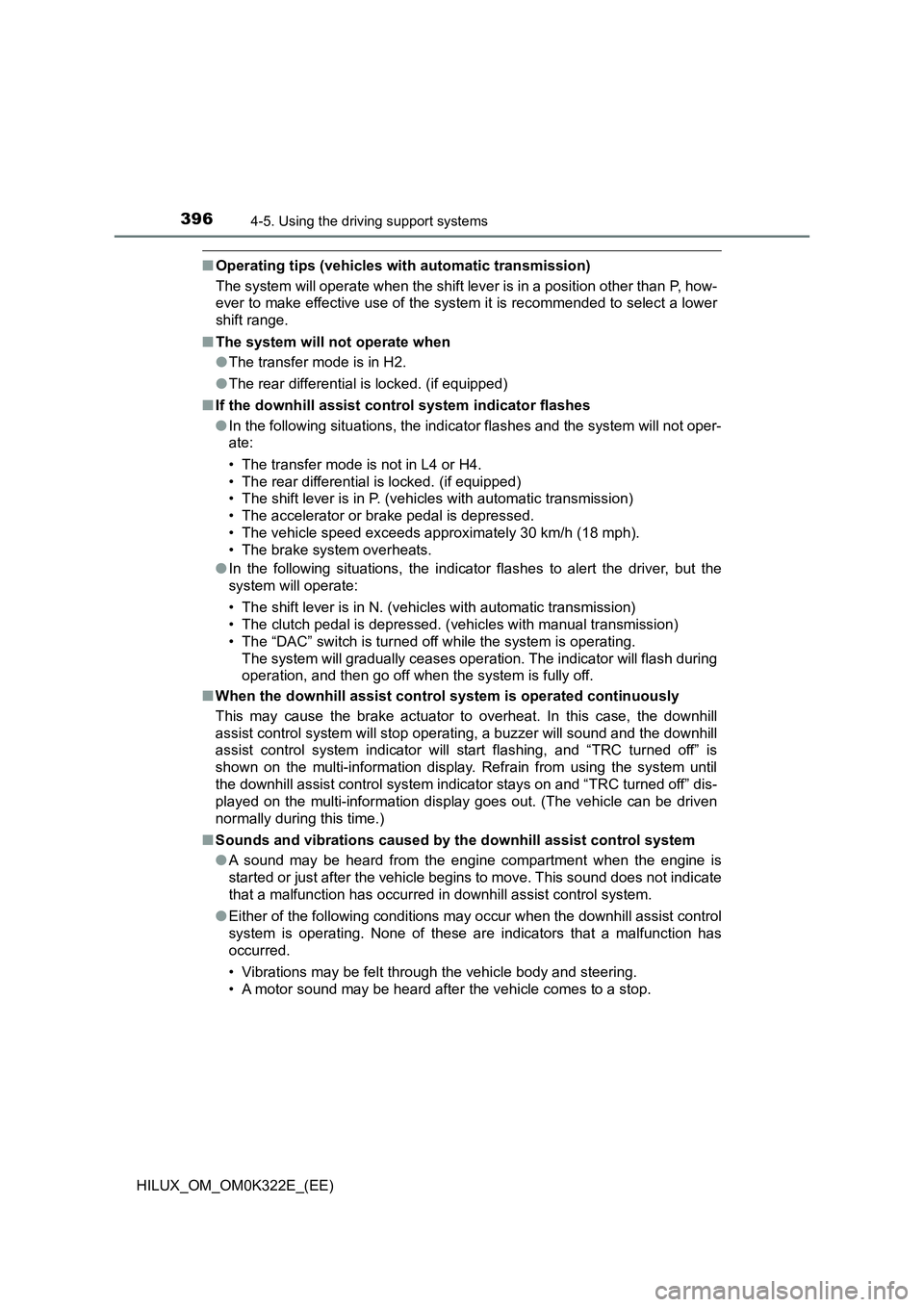
3964-5. Using the driving support systems
HILUX_OM_OM0K322E_(EE)
■Operating tips (vehicles with automatic transmission)
The system will operate when the shift lever is in a position other than P, how-
ever to make effective use of the system it is recommended to select a lower
shift range.
■ The system will not operate when
● The transfer mode is in H2.
● The rear differential is locked. (if equipped)
■ If the downhill assist control system indicator flashes
● In the following situations, the indicator flashes and the system will not oper-
ate:
• The transfer mode is not in L4 or H4.
• The rear differential is locked. (if equipped)
• The shift lever is in P. (vehicles with automatic transmission)
• The accelerator or brake pedal is depressed.
• The vehicle speed exceeds approximately 30 km/h (18 mph).
• The brake system overheats.
● In the following situations, the indicator flashes to alert the driver, but the
system will operate:
• The shift lever is in N. (vehicles with automatic transmission)
• The clutch pedal is depressed. (vehicles with manual transmission)
• The “DAC” switch is turned off while the system is operating.
The system will gradually ceases operat ion. The indicator will flash during
operation, and then go off when the system is fully off.
■ When the downhill assist control system is operated continuously
This may cause the brake actuator to overheat. In this case, the downhill
assist control system will stop operating, a buzzer will sound and the downhill
assist control system indicator will start flashing, and “TRC turned off” is
shown on the multi-information display. Refrain from using the system until
the downhill assist control system indicator stays on and “TRC turned off” dis-
played on the multi-information display goes out. (The vehicle can be driven
normally during this time.)
■ Sounds and vibrations caused by the downhill assist control system
● A sound may be heard from the engine compartment when the engine is
started or just after the vehicle begins to move. This sound does not indicate
that a malfunction has occurred in downhill assist control system.
● Either of the following conditions may occur when the downhill assist control
system is operating. None of these are indicators that a malfunction has
occurred.
• Vibrations may be felt through the vehicle body and steering.
• A motor sound may be heard after the vehicle comes to a stop.
Page 397 of 720

3974-5. Using the driving support systems
4
Driving
HILUX_OM_OM0K322E_(EE)
■ System malfunction
In the following cases, have your vehicle checked by any authorized Toyota
retailer or Toyota authorized repairer, or any reliable repairer.
● The downhill assist control system indicator does not come on when the
engine switch is turned to the “ON” position (vehicles without smart entry &
start system) or IGNITION ON mode (vehicles with smart entry & start sys-
tem).
● The downhill assist control system indicator does not come on when the
“DAC” switch is pressed.
● The slip indicator comes on.
WARNING
■When using downhill assist control system
● Do not rely overmuch on the downhill assist control system. This function
does not extend the vehicle’s performance limitations. Always thoroughly
check the road conditions, and drive safely.
● Vehicles with manual transmission: Drive in a low gear. Driving in a high
gear when using downhill assist control system may cause the engine to
stall, which may lose the brake effectiveness and lock the tires, resulting in
an accident.
● Vehicles with manual transmission: On a steep slope, use the engine brak-
ing efficiently. If the vehicle is driven in N or with the clutch pedal
depressed on a steep slope, the load on the brake increases and con-
trolling the vehicle speed may be impossible, resulting in an accident.
■ The system may not operate on the following surfaces, which may lead
to an accident causing death or serious injury
● Slippery surfaces such as wet or muddy roads
● Icy surface
● Unpaved roads
Page 400 of 720
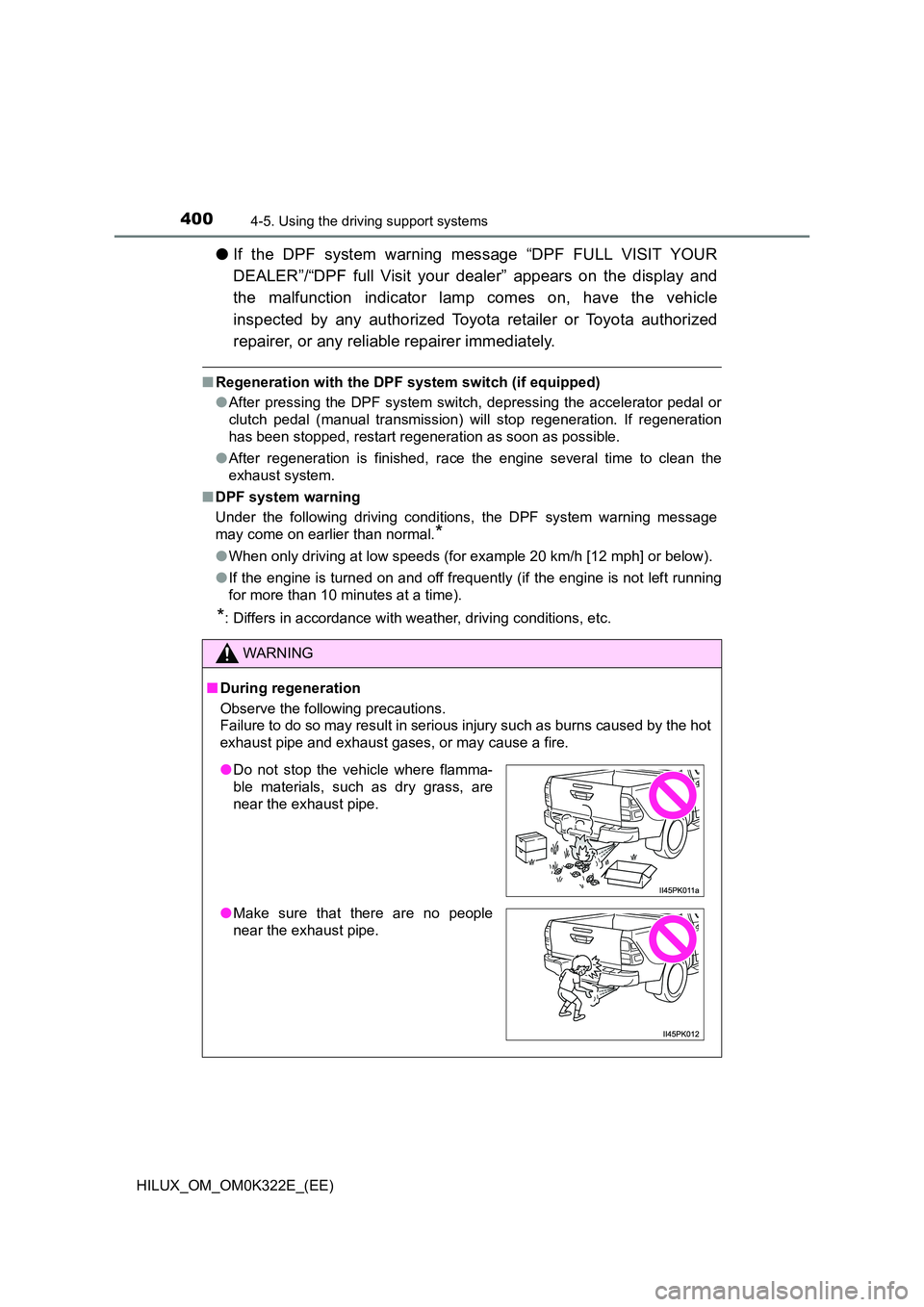
4004-5. Using the driving support systems
HILUX_OM_OM0K322E_(EE)
●If the DPF system warning message “DPF FULL VISIT YOUR
DEALER”/“DPF full Visit your dealer” appears on the display and
the malfunction indicator lamp comes on, have the vehicle
inspected by any authorized Toyota retailer or Toyota authorized
repairer, or any reliable repairer immediately.
■ Regeneration with the DPF system switch (if equipped)
● After pressing the DPF system switch, depressing the accelerator pedal or
clutch pedal (manual transmission) will stop regeneration. If regeneration
has been stopped, restart regeneration as soon as possible.
● After regeneration is finished, race the engine several time to clean the
exhaust system.
■ DPF system warning
Under the following driving conditions, the DPF system warning message
may come on earlier than normal.*
● When only driving at low speeds (for example 20 km/h [12 mph] or below).
● If the engine is turned on and off frequently (if the engine is not left running
for more than 10 minutes at a time).
*: Differs in accordance with weather, driving conditions, etc.
WARNING
■ During regeneration
Observe the following precautions.
Failure to do so may result in serious injury such as burns caused by the hot
exhaust pipe and exhaust gases, or may cause a fire.
● Do not stop the vehicle where flamma-
ble materials, such as dry grass, are
near the exhaust pipe.
● Make sure that there are no people
near the exhaust pipe.
Page 541 of 720
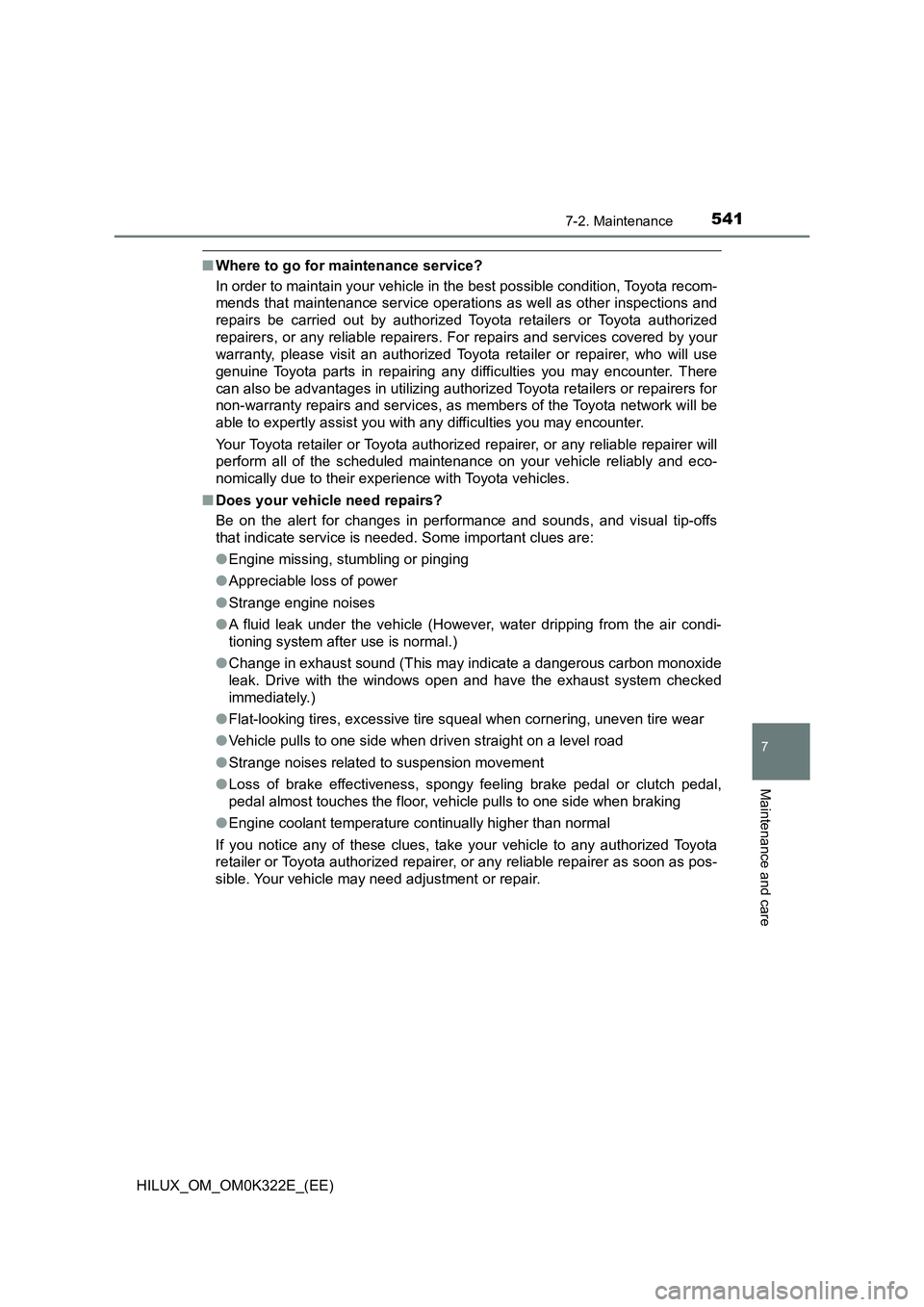
5417-2. Maintenance
HILUX_OM_OM0K322E_(EE)
7
Maintenance and care
■Where to go for maintenance service?
In order to maintain your vehicle in the best possible condition, Toyota recom-
mends that maintenance service operations as well as other inspections and
repairs be carried out by authorized Toyota retailers or Toyota authorized
repairers, or any reliable repairers. For repairs and services covered by your
warranty, please visit an authorized Toyota retailer or repairer, who will use
genuine Toyota parts in repairing any difficulties you may encounter. There
can also be advantages in utilizing authorized Toyota retailers or repairers for
non-warranty repairs and services, as members of the Toyota network will be
able to expertly assist you with any difficulties you may encounter.
Your Toyota retailer or Toyota authoriz ed repairer, or any reliable repairer will
perform all of the scheduled maintenance on your vehicle reliably and eco-
nomically due to their experience with Toyota vehicles.
■ Does your vehicle need repairs?
Be on the alert for changes in performance and sounds, and visual tip-offs
that indicate service is needed. Some important clues are:
● Engine missing, stumbling or pinging
● Appreciable loss of power
● Strange engine noises
● A fluid leak under the vehicle (However, water dripping from the air condi-
tioning system after use is normal.)
● Change in exhaust sound (This may indicate a dangerous carbon monoxide
leak. Drive with the windows open and have the exhaust system checked
immediately.)
● Flat-looking tires, excessive tire squeal when cornering, uneven tire wear
● Vehicle pulls to one side when driven straight on a level road
● Strange noises related to suspension movement
● Loss of brake effectiveness, spongy feeling brake pedal or clutch pedal,
pedal almost touches the floor, vehicle pulls to one side when braking
● Engine coolant temperature continually higher than normal
If you notice any of these clues, take your vehicle to any authorized Toyota
retailer or Toyota authorized repairer, or any reliable repairer as soon as pos-
sible. Your vehicle may need adjustment or repair.
Page 643 of 720
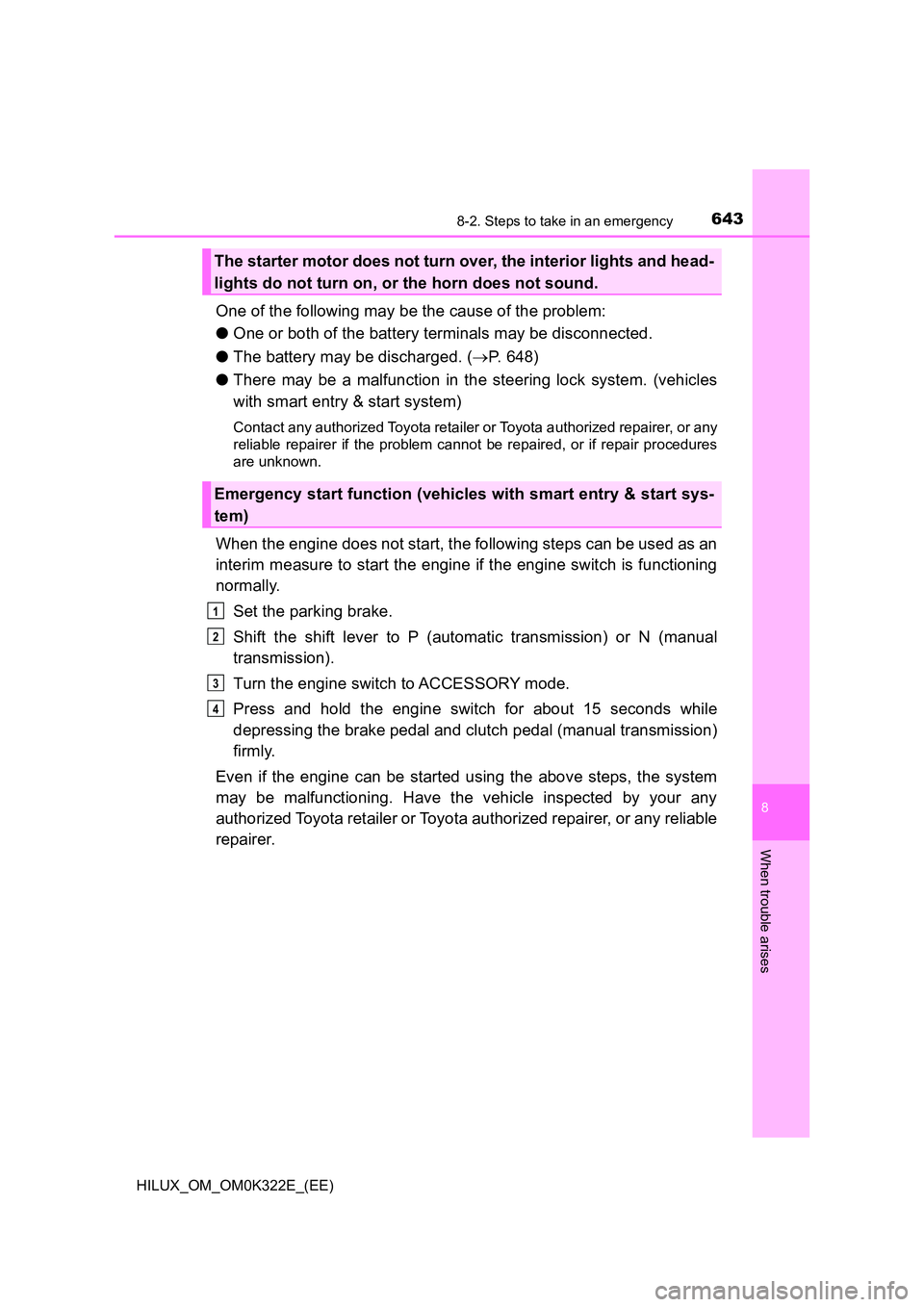
6438-2. Steps to take in an emergency
HILUX_OM_OM0K322E_(EE)
8
When trouble arises
One of the following may be the cause of the problem:
● One or both of the battery terminals may be disconnected.
● The battery may be discharged. (P. 648)
● There may be a malfunction in the steering lock system. (vehicles
with smart entry & start system)
Contact any authorized Toyota retailer or Toyota authorized repairer, or any
reliable repairer if the problem cannot be repaired, or if repair procedures
are unknown.
When the engine does not start, the following steps can be used as an
interim measure to start the engine if the engine switch is functioning
normally.
Set the parking brake.
Shift the shift lever to P (automatic transmission) or N (manual
transmission).
Turn the engine switch to ACCESSORY mode.
Press and hold the engine switch for about 15 seconds while
depressing the brake pedal and clutch pedal (manual transmission)
firmly.
Even if the engine can be started using the above steps, the system
may be malfunctioning. Have the vehicle inspected by your any
authorized Toyota retailer or Toyota authorized repairer, or any reliable
repairer.
The starter motor does not turn over, the interior lights and head-
lights do not turn on, or the horn does not sound.
Emergency start function (vehicles with smart entry & start sys-
tem)
1
2
3
4
Page 646 of 720
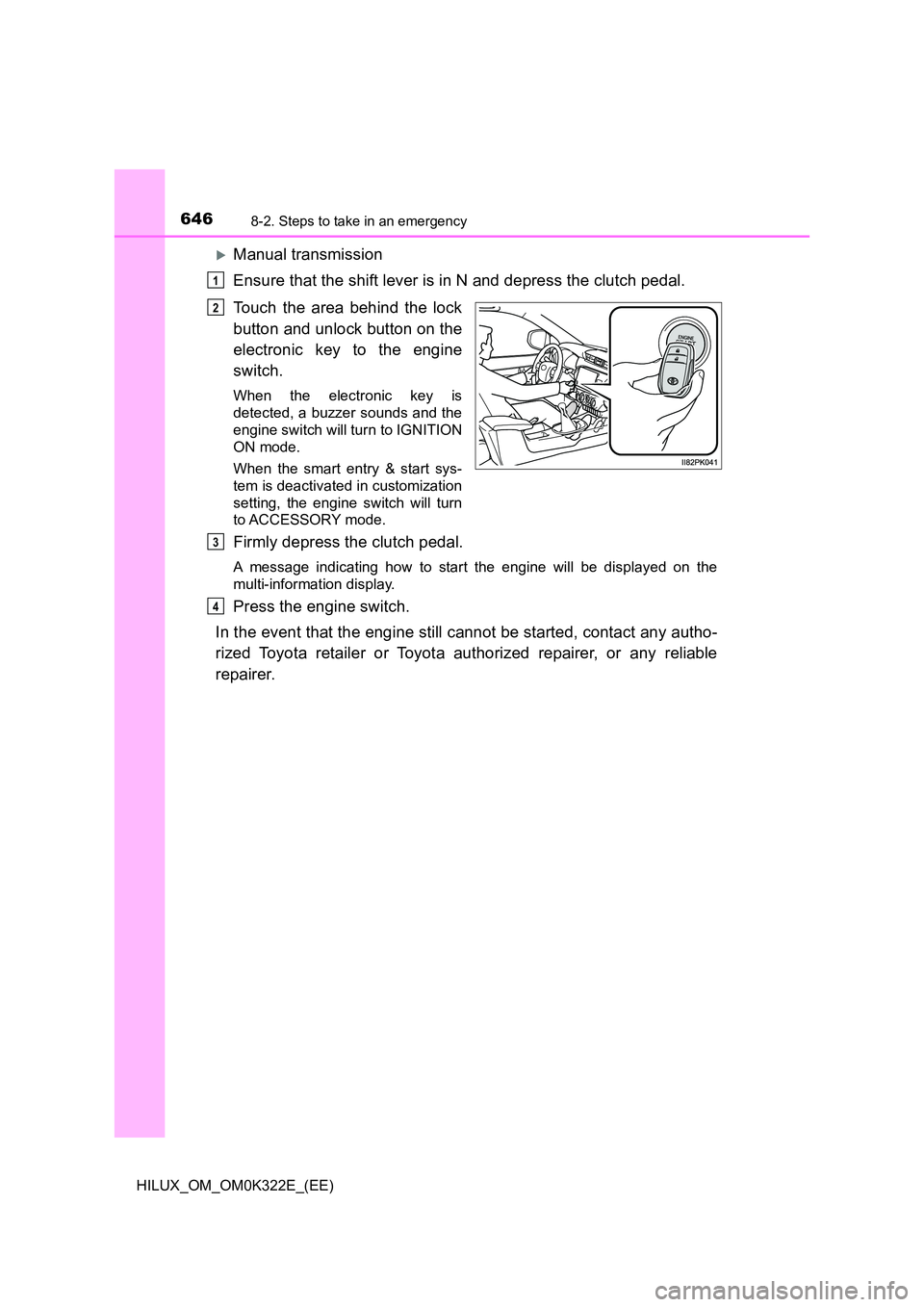
6468-2. Steps to take in an emergency
HILUX_OM_OM0K322E_(EE)
Manual transmission
Ensure that the shift lever is in N and depress the clutch pedal.
Touch the area behind the lock
button and unlock button on the
electronic key to the engine
switch.
When the electronic key is
detected, a buzzer sounds and the
engine switch will turn to IGNITION
ON mode.
When the smart entry & start sys-
tem is deactivated in customization
setting, the engine switch will turn
to ACCESSORY mode.
Firmly depress the clutch pedal.
A message indicating how to start the engine will be displayed on the
multi-information display.
Press the engine switch.
In the event that the engine still cannot be started, contact any autho-
rized Toyota retailer or Toyota authorized repairer, or any reliable
repairer.
1
2
3
4
Page 647 of 720

6478-2. Steps to take in an emergency
HILUX_OM_OM0K322E_(EE)
8
When trouble arises
■Stopping the engine
Shift the shift lever to P (automatic transmission) or N (manual transmission)
and press the engine switch as you normally do when stopping the engine.
■ Replacing the key battery
As the above procedure is a temporary measure, it is recommended that the
electronic key battery be replaced immediately when the battery is depleted.
( P. 575)
■ Alarm (vehicles with alarm for Kazakhstan, Armenia, Georgia,
Turkmenistan and Morocco)
Using the mechanical key to lock the doors will not set the alarm system.
If a door is unlocked using the mechanical key when the alarm system is set,
the alarm may be triggered.
■ Changing engine switch modes
Release the brake pedal (automatic transmission) or clutch pedal (manual
transmission) and press the engine switch in step above.
The engine does not start and modes will be changed each time the switch is
pressed. ( P. 272)
■ When the electronic key does not work properly
● Make sure that the smart entry & start system has not been deactivated in
the customization setting. If it is off, turn the function on.
(Customizable features: P. 695)
● Check if battery-saving mode is set. If it is set, cancel the function.
( P. 185)
3
Page 687 of 720
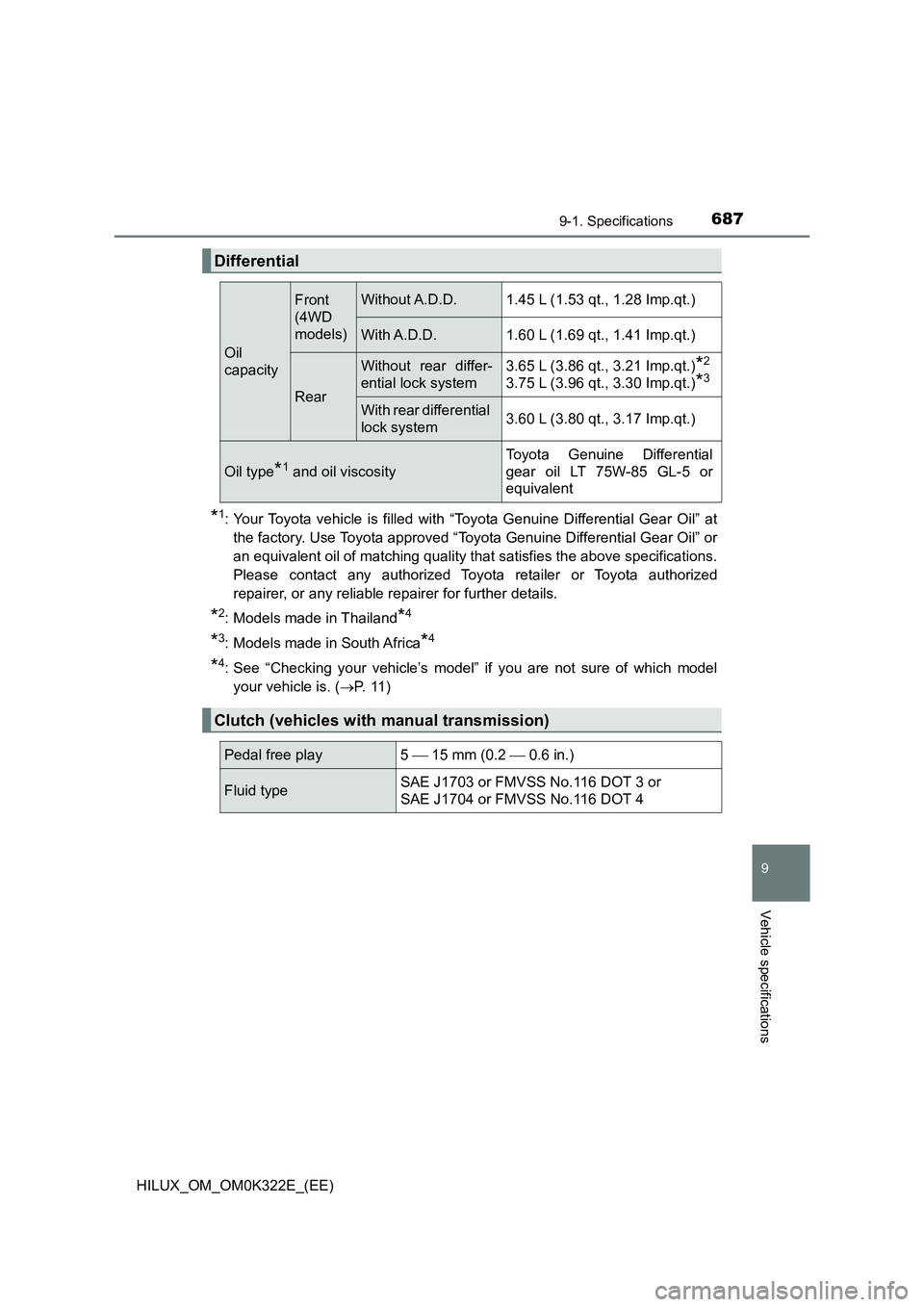
687
9
9-1. Specifications
Vehicle specifications
HILUX_OM_OM0K322E_(EE)
*1: Your Toyota vehicle is filled with “Toyota Genuine Differential Gear Oil” at
the factory. Use Toyota approved “Toyota Genuine Differential Gear Oil” or
an equivalent oil of matching quality that satisfies the above specifications.
Please contact any authorized Toyota retailer or Toyota authorized
repairer, or any reliable repairer for further details.
*2: Models made in Thailand*4
*3: Models made in South Africa*4
*4: See “Checking your vehicle’s model” if you are not sure of which model
your vehicle is. ( P. 1 1 )
Differential
Oil
capacity
Front
(4WD
models)
Without A.D.D.1.45 L (1.53 qt., 1.28 Imp.qt.)
With A.D.D.1.60 L (1.69 qt., 1.41 Imp.qt.)
Rear
Without rear differ-
ential lock system
3.65 L (3.86 qt., 3.21 Imp.qt.)*2
3.75 L (3.96 qt., 3.30 Imp.qt.)*3
With rear differential
lock system3.60 L (3.80 qt., 3.17 Imp.qt.)
Oil type*1 and oil viscosity
Toyota Genuine Differential
gear oil LT 75W-85 GL-5 or
equivalent
Clutch (vehicles with manual transmission)
Pedal free play 5 15 mm (0.2 0.6 in.)
Fluid type SAE J1703 or FMVSS No.116 DOT 3 or
SAE J1704 or FMVSS No.116 DOT 4